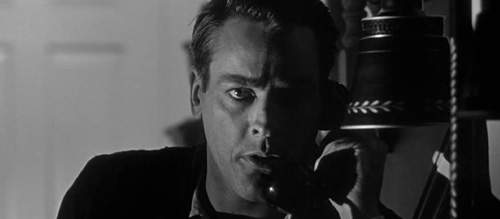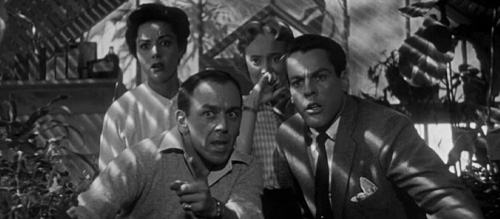Invasion of the Body Snatchers (1956) Review
Invasion of the Body Snatchers (1956)
Director: Don Siegel
Screenwriters: Daniel Mainwaring
Starring: Kevin McCarthy, Dana Wynter, Larry Gates, King Donovan, Carolyn Jones, Jean Willes, Ralph Dumke
In the 1950s, American sci-fi horror entered an age of two new zeitgeists. One was the atomic age fear, which gave us our big monster movies such as Them! and The Beast From 20,000 Fathoms. The other came slap bang in the middle of the Red Scare, fuelled by anti-communist fears and sentiments roused by McCarthyism and Hollywood blacklisting. Here, the genres found a way to direct these feelings into their films. Movies such as The Thing from Another World (based on the novella “Who Goes There?!” by John W. Campbell) and It Came from Outer Space played heavily into these ideas, presenting alien threats that appeared like humans, wanting to take us over invisibly, substituting our individuality for a like-minded, homogenous whole, as an allegory for the individual-identity-stealing threat of communism. Around the same time, John Wyndham over in England published “The Midwich Cuckoos”, and Robert A. Heinlein wrote “The Puppet Masters”. It was a whole craze. And although Jack Finney, who penned Invasion of the Body Snatchers’ original novel in 1954, would go on record to say that there was no anti-communist themes present, it is ironic that the book, and the first of four adaptations, would be perhaps the most influential of all Cold War sci-fi horror stories.
In this 1956 film, Dr Miles (played by Kevin McCarthy) is brought into a police station in the dead of night, ranting and raving that there’s not much time left to stop “it”. He then proceeds to explain exactly what needs stopping, and what unfolds is a story of alien possession in the small town of Santa Mira and a conspiracy to replace everyone in the world with emotionless duplicates formed by giant alien seed pods.
What is perhaps most pleasing about Invasion of the Body Snatchers is its pacing. Whilst the first half is mostly the build up towards the unveiling of the conspiracy, it nonetheless has to manage multiple issues at a time. It must build up the feeling of dread, of something lurking under the surface. It must introduce and keep us entertained with our main characters. And it must stop us getting bored whilst its slow, creeping menace worms its way into our thudding chests. Invasion manages to do this wonderfully, with every scene advancing character and plot and menace incredibly deftly. By the time the reality of the situation is revealed, you understand that you’ve been watching it all happen, too slow to put the pieces together, and now it’s all hopelessly too late.
Handled by Don Siegel’s wonderful direction, we have chilling moments such as a whole town descending on a square to begin distributing the pods to the world, and the ‘birthing’ of the clones from the great gooey seeds. With the striking and memorable final moments of a character screaming “They’re here already! You’re next! You’re next!” in the middle of a busy highway, low angled, tilted, harsh lighting, surrounded by uniform car lights not heeding his warning, we suddenly understand that an outside invasion isn’t the only form of hive-mind takeover in the world. Mass consumerism, the dazzling lights of 20th century industry, the inability to heed the individual fellow man, it’s all here. We are all pod people in one way or another. The sense of futility and nihilism has rarely been matched since.

There are times when the voice over (an incredibly common trope for sci-fi movies of the time, especially very low budget ones) is not needed, and can get in the way of the action unfolding on screen, which itself is a visual representation of this same recounting of events by telling exactly what we’re already seeing, but thankfully this interjection only occurs a few times throughout the film and is in no way overbearing. It is mostly gone for the final half of the film, when the momentum kicks into overdrive and everything runs at a thousand miles per hour as the conspiracy unfolds, so at least it knows to keep back when our attention is needed the most.
Invasion of the Body Snatchers (1954) teaches us that nobody can be trusted. Everyone is in on the conspiracy, and even law enforcement, phone companies, doctors, mayors, grocers, are out to get you. Decades later, in 1987, Andrew Tudor would outline his definition of ‘paranoid horror’ in his textbook “Monsters and Mad Scientists”, claiming the fundamental shift was in 1960 thanks to the killer-next-door films Psycho and Peeping Tom. The breakdown of the authority figure, the terror from within the circle of safety, the transmutation of the flesh, disease; all these ideas he outlines as part of his theory. He does acknowledge, however, that some films before 1960 played up the paranoid nature of the threat not coming from outside, but from within. Invasion of the Body Snatchers is right on the cusp of this transition, and in an incredible 80 minutes worms its way into our minds, our hearts, and cinematic culture. With remarkable ideas, direction, staging, and some great central performances, locked into place by a terrific open ending, Don Siegel’s classic is right to be revered as such, going above being a schlock horror picture show to become something far more important.
Score: 20/24


